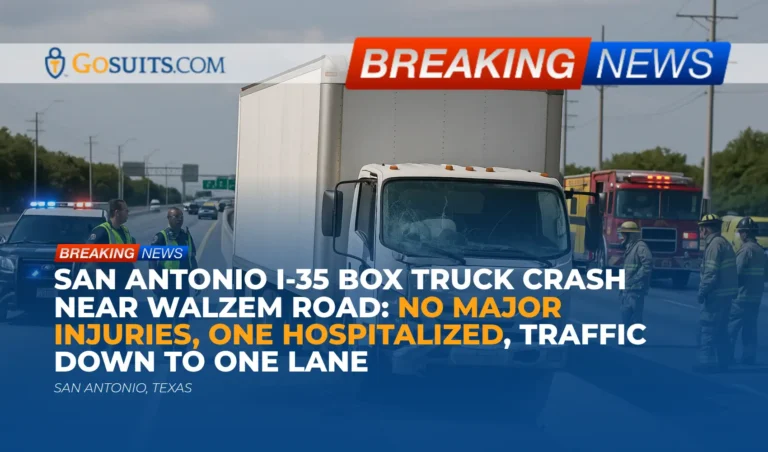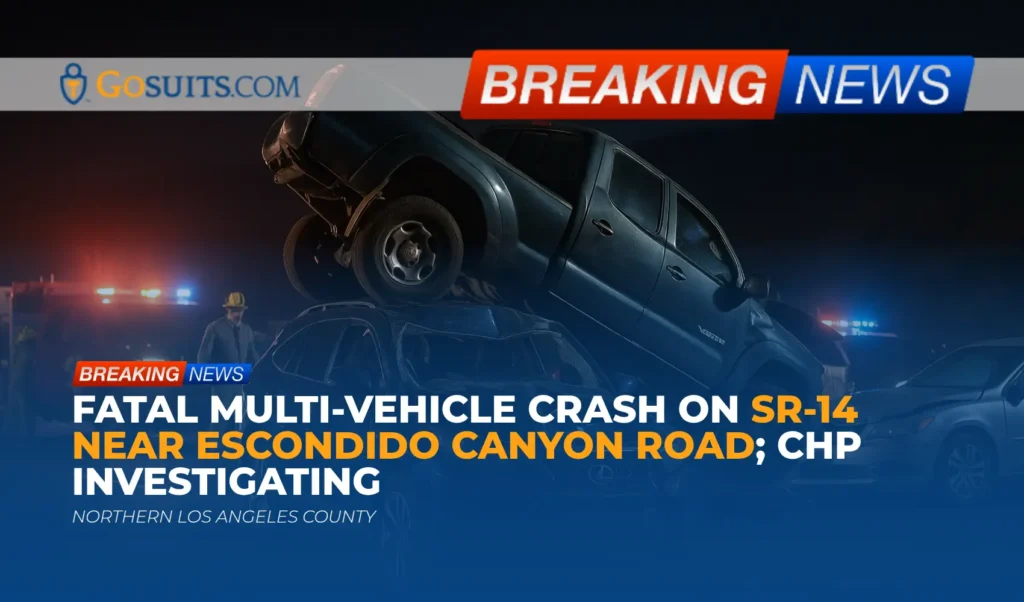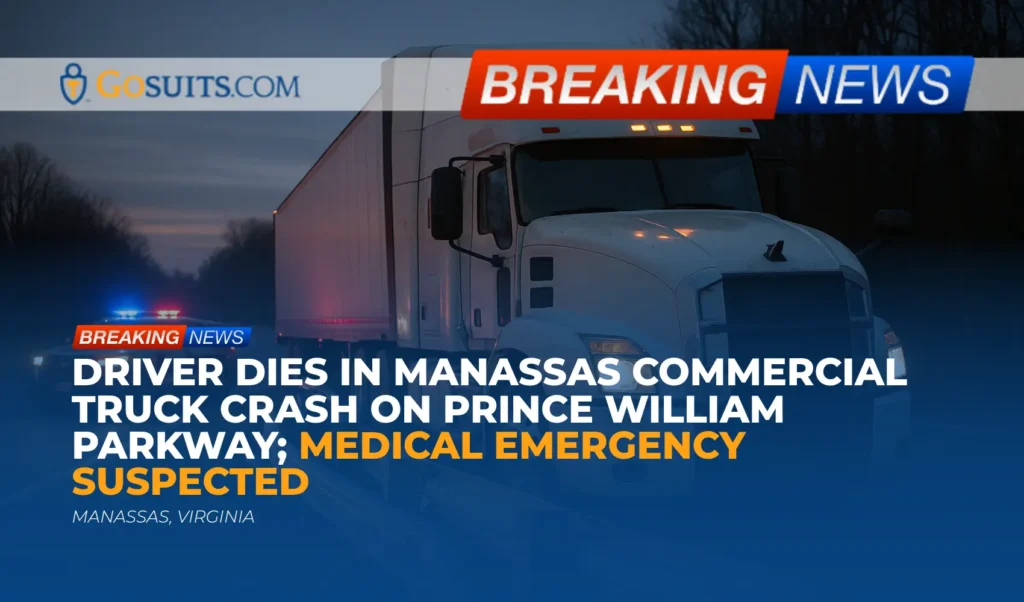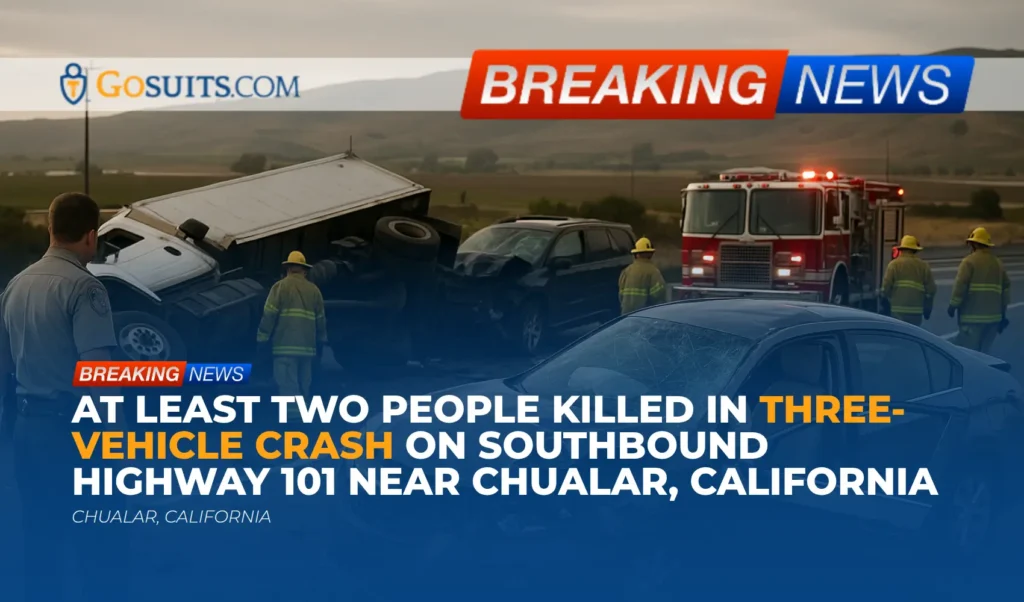- What We Know About the I-35 Box Truck Crash Near Walzem Road
- Roadway and Traffic Conditions Reported
- Why Box Truck Crashes Raise Special Safety Concerns
- Common Injuries in Seemingly “Minor” Truck Collisions
- Immediate Steps to Consider After a Crash on I-35
- How to Get Official Records and Information
- San Antonio Police Department Crash Report
- TxDOT Crash Records Information System (CRIS)
- EMS and Hospital Records
- County Medical Examiner Information (if applicable)
- Commercial Carrier Duties and Compliance
- Preservation of Evidence After a Truck Crash
- Comparative Fault and Insurance in Texas
- Statute of Limitations Snapshot
- Safety Tips for Drivers When Traffic Is Down to One Lane
- Data and Trends: Large Truck Crashes in Texas
- Commentary from Gosuits San Antonio, Texas Personal Injury Attorney
- Why Acting Promptly Matters After a Commercial Vehicle Crash
What We Know About the I-35 Box Truck Crash Near Walzem Road
Authorities reported a box truck crash on Interstate 35 northbound near the Walzem Road exit in San Antonio. The collision occurred at approximately 10:15 a.m. on a Thursday. Police indicated there were no major injuries. One driver was transported to a hospital for medical treatment. Traffic in the northbound lanes was reduced to one lane as responders managed the scene and cleared the roadway.
While details remain limited, the early information suggests this event caused a significant traffic slowdown but did not result in life-threatening harm. Even when injuries are described as non-major, follow-up medical evaluation is still important, as symptoms from crashes sometimes emerge over hours or days. This article outlines the practical steps to obtain official information, discusses common issues in box truck collisions, and explains general civil law considerations in Texas.
Roadway and Traffic Conditions Reported
According to initial on-scene updates, northbound I-35 near the Walzem Road exit was restricted to a single lane after the crash. Lane reductions can increase the risk of secondary collisions as drivers approach congestion at highway speeds and may not anticipate stopped or slow-moving vehicles ahead. Federal guidance emphasizes safe practices around incident scenes and work zones, including slowing down and avoiding distractions. For broader safety information, see the National Highway Traffic Safety Administration’s materials on roadway safety at NHTSA Road Safety.
Responders typically prioritize triage, scene safety, and clearing disabled vehicles to restore normal traffic flow. Drivers approaching such scenes should be especially cautious, leave ample following distance, and obey responder directions.
Why Box Truck Crashes Raise Special Safety Concerns
Box trucks operate as commercial motor vehicles and often carry cargo that can shift during sudden stops or impacts. Their weight and design can result in longer stopping distances and more force in a collision compared to passenger cars. The Federal Motor Carrier Safety Administration (FMCSA) provides nationwide research on large truck safety and regulations that carriers and drivers are expected to follow. For general regulatory context and safety data, see FMCSA Safety.
Unique risk factors associated with box trucks include:
- Stopping distance and blind spots due to vehicle size and weight.
- Cargo shift if loads are not properly secured or balanced, potentially affecting vehicle stability and handling.
- High center of gravity that can increase rollover risk during abrupt maneuvers.
- Driver fatigue or scheduling pressures if a commercial driver’s hours are not managed within federal limits; see FMCSA’s guidance on hours-of-service rules at FMCSA Hours of Service.
When commercial vehicles are involved in a crash, questions can arise about vehicle maintenance, driver qualifications, hours-of-service compliance, cargo securement, and company safety policies. Those issues can influence whether a carrier may be responsible under civil law for resulting harms.
Common Injuries in Seemingly “Minor” Truck Collisions
Even when police describe injuries as non-major, symptoms can evolve. Some common injuries after low-to-moderate speed crashes include:
- Soft-tissue injuries such as sprains and strains affecting the neck, back, or shoulders.
- Concussions and mild traumatic brain injuries that may present later with headaches, dizziness, difficulty concentrating, or sensitivity to light and noise.
- Bruising and contusions from seatbelts or vehicle components.
- Exacerbation of preexisting conditions like degenerative disc disease that becomes symptomatic after impact.
For general guidance on concussion signs and the importance of medical evaluation after head impacts, see the Centers for Disease Control and Prevention’s resources at CDC Traumatic Brain Injury. NHTSA also provides occupant protection information, including seat belt effectiveness, at NHTSA Seat Belts.
Immediate Steps to Consider After a Crash on I-35
Each crash is unique, but these general steps can help protect safety and preserve information:
- Prioritize medical care. Seek a medical assessment promptly, even if injuries seem minor. Documenting symptoms early can support continuity of care.
- Document the scene if safe. Photographs of vehicle positions, debris, skid marks, and traffic conditions can be useful later. If documentation was not possible at the time, returning to photograph the area or noting the precise mile marker and exit location can still help.
- Identify witnesses. Names and contact details of witnesses can assist in clarifying what happened.
- Preserve vehicle and personal property. Avoid repairing or discarding damaged parts until they are photographed or inspected. In commercial vehicle cases, inspection of the truck, tires, brakes, and cargo securement can be important.
- Be cautious with insurance communications. Before giving recorded statements to any insurer, speak with a qualified attorney during a free consultation to understand your rights. Statements can be used later and may affect fault and compensation determinations. The Texas Department of Insurance provides consumer-facing information on auto claims at TDI Auto Claims.
How to Get Official Records and Information
Official records help clarify what happened and can be necessary for insurance claims. In Texas, crash reports are governed by the Transportation Code and are maintained at the local level and by the Texas Department of Transportation (TxDOT).
San Antonio Police Department Crash Report
Crash reports for incidents within San Antonio city limits are created by responding officers when reporting thresholds are met. Texas law outlines when a report is required and how it must be filed; see Texas Transportation Code Chapter 550.
To request a San Antonio Police Department (SAPD) crash report or inquire about availability:
- Check SAPD’s Records and Reports page: San Antonio Police Records.
- Have key details ready: date and time (10:15 a.m., Thursday), highway and exit (I-35 northbound near Walzem Road), and involved vehicle types (including a box truck). If you were a party to the crash, provide driver information to verify identity.
- Public Information requests may be used for certain records. SAPD provides instructions for public records requests at San Antonio Public Information Act Requests.
TxDOT Crash Records Information System (CRIS)
TxDOT maintains statewide crash reports submitted by law enforcement in the Crash Records Information System (CRIS). Parties involved in a crash, their representatives, insurers, and certain others can purchase copies. See TxDOT Crash Reports.
Important points about CRIS:
- Eligibility: Texas law restricts who may obtain a crash report. See the policy guidance referenced at TxDOT Crash Reports and Transportation Code Section 550.065 for confidentiality provisions at Texas Transportation Code 550.065.
- Information needed: approximate date, location, and at least one involved name or driver’s license number can help locate the report.
- Timeframe: It can take days to weeks for a report to be finalized and uploaded, especially if supplemental narratives or diagrams are pending.
EMS and Hospital Records
Emergency medical services records and hospital records can document injuries, symptoms, and treatment plans. In San Antonio, EMS services are provided by the San Antonio Fire Department (SAFD). For general information about EMS records or to inquire about obtaining a copy, see San Antonio EMS.
Medical records are protected by privacy laws. Patients or their authorized representatives can generally request copies under HIPAA and relevant Texas law; see the Texas Health and Safety Code provisions at Health and Safety Code Chapter 181. Requesting records may involve an authorization form, identification, and applicable fees.
County Medical Examiner Information (if applicable)
This incident was reported as involving no major injuries and no fatalities. However, in serious or fatal collisions, next of kin often seek assistance from the county medical examiner for information about examinations, reports, and release procedures. Each Texas county’s medical examiner or justice of the peace handles these matters according to state law and local procedures. For general legal requirements surrounding death investigations and examinations, see the Code of Criminal Procedure, Chapter 49 at Texas CCP Chapter 49.

Understanding Potential Civil Liability in Texas
Although initial reports indicate no major injuries, commercial vehicle collisions raise recurring legal questions. Civil liability depends on the specific facts, including who acted negligently and whether any safety regulations were violated. Below are general Texas concepts that commonly apply.
Commercial Carrier Duties and Compliance
Commercial carriers and their drivers must operate reasonably and comply with state and federal safety rules. Relevant considerations may include:
- Driver qualifications and training, including appropriate commercial licensing when required and familiarity with urban interstate traffic.
- Hours-of-service compliance, ensuring drivers are not operating while fatigued. See FMCSA Hours of Service.
- Vehicle inspection and maintenance practices, particularly brake, tire, and lighting systems.
- Cargo securement to prevent shifting loads. General federal guidance is available through FMCSA at FMCSA Cargo Securement Rules.
When a commercial driver’s negligence causes a crash, the employer may be responsible under vicarious liability principles. If a company’s own policies or maintenance practices contributed to the dangerous condition, direct liability theories may also be considered.
Preservation of Evidence After a Truck Crash
Evidence can degrade quickly after a roadway incident. In a commercial-vehicle crash, potential evidence includes:
- Event data from the truck (engine control modules and telematics), which may record speed, braking, and throttle information.
- Driver logs, electronic logging device (ELD) data, and dispatch communications.
- Pre- and post-trip inspection records and maintenance files.
- Cargo documents, bills of lading, and load securement records.
- Body-worn camera and dash-camera video from officers or responding agencies, if available through lawful public information channels.
Timely written requests to preserve evidence, often called preservation or spoliation letters, can notify involved parties to retain relevant information.
Comparative Fault and Insurance in Texas
Texas applies proportionate responsibility rules. Recovery can be reduced by a person’s percentage of fault and barred if responsibility exceeds a threshold. For the statutory framework, see the Texas Civil Practice and Remedies Code Chapter 33 at CPRC Chapter 33.
Insurance playbook considerations:
- Recorded statements given to an insurer may be used to assign fault or minimize injury claims. It is generally prudent to speak with an attorney in a free consultation before agreeing to a recorded statement.
- Property damage and rental issues can move quickly; keep receipts and estimates and document all communications.
- Medical payment flows may involve Personal Injury Protection (PIP) or MedPay if purchased, as well as health insurance coordination. The Texas Department of Insurance offers consumer information on auto coverages at TDI Auto Insurance Guide.
Statute of Limitations Snapshot
Most Texas personal injury claims have a two-year limitations period measured from the date of the incident, subject to exceptions. See Texas Civil Practice and Remedies Code § 16.003. Because deadlines can be affected by the facts, timely legal guidance is important.
Safety Tips for Drivers When Traffic Is Down to One Lane
Single-lane traffic on busy corridors like I-35 can be dangerous. To reduce risk:
- Slow well before the bottleneck. Sudden slowdowns can trigger chain-reaction crashes.
- Signal early when merging and leave space for others.
- Avoid distractions. Keep eyes up for responders and any pedestrians working the scene.
- Do not rubberneck. Looking at crash scenes increases risk of secondary collisions.
- Follow Move Over/Slow Down requirements. Texas law requires drivers to slow down or move over for certain stopped vehicles with flashing lights. For general safety guidance, see NHTSA’s roadway safety overview at NHTSA Road Safety.
Data and Trends: Large Truck Crashes in Texas
Texas experiences a high volume of commercial motor vehicle traffic. State and federal resources provide context on truck crash trends:
- TxDOT statewide crash facts: The Texas Department of Transportation annually publishes crash statistics, including commercial vehicle involvement. See the latest “Motor Vehicle Traffic Crash Facts” and related reports at TxDOT Traffic Safety Reports.
- FMCSA large truck safety research: FMCSA compiles national data on large truck crashes and contributing factors. See FMCSA Data and Statistics.
- NHTSA national trends: NHTSA provides national crash data summaries and research on occupant protection and driver behavior: NHTSA Research and Data.
While the crash near Walzem Road was initially reported as not causing major injuries, the broader data remind us that even nonfatal truck collisions can result in injuries that require care and may create long-term impacts if untreated.
Commentary from Gosuits San Antonio, Texas Personal Injury Attorney
Our hearts go out to everyone affected by the box truck crash on I-35 near the Walzem Road exit. Morning highway collisions disrupt daily life and can leave people worried, sore, and unsure about next steps. This commentary is for general educational purposes and is not a substitute for individual legal guidance.
From a civil-injury perspective, even a single-lane closure incident can raise important questions: Was the box truck’s speed appropriate for traffic conditions? Was cargo secured? Did any maintenance or visibility issues contribute? Answers typically come from a combination of the police report, photographs, vehicle inspections, and, when appropriate, electronic data. In our experience handling roadway cases, the early collection of information often shapes outcomes down the line.
Insurance companies and commercial carriers are skilled at protecting their financial interests. Adjusters may quickly request a recorded statement or encourage fast settlements before the full scope of injuries is known. Without understanding how fault is determined under Texas comparative responsibility rules, or how medical documentation affects claim valuation, people can inadvertently say or do things that reduce their recovery. Being cautious with statements and paperwork matters, because what is said to an insurer can be used later in ways that are hard to undo.
Speaking with a seasoned and skilled personal injury attorney in a free consultation can help clarify rights and timelines before engaging with insurers. That preliminary conversation can cover topics like medical follow-up, preserving evidence, understanding property damage processes, and identifying coverages that might apply. Taking that step early can help avoid common pitfalls.

Why Acting Promptly Matters After a Commercial Vehicle Crash
There are concrete reasons to take well-planned steps soon after a crash, even one initially described as involving no major injuries.
- Confirm health status. Prompt medical evaluation can detect issues that are not obvious at the scene. Early documentation supports appropriate treatment planning and helps establish a timeline if symptoms evolve.
- Preserve time-sensitive evidence. Vehicle data, dashcam footage, surveillance videos, and witness memories fade quickly. Early preservation requests improve the chances that crucial information is not lost.
- Align with legal deadlines. Texas has firm filing deadlines for personal injury claims. Starting early allows time to investigate, obtain records, and evaluate options without last-minute pressure.
- Avoid missteps with insurers. Recorded statements, medical authorizations, and settlement releases can have lasting effects. Before contacting an insurance company to make a claim, it is prudent to consult with an attorney in a free consultation to understand rights and potential risks. Statements made to insurers can be used against the person later on.
- Clarify coverage and benefits. Coordinating auto and health insurance, understanding deductibles, and confirming whether PIP or MedPay exist can help manage bills and reduce stress.
- Document property damage thoroughly. Photographs, repair estimates, and records of rental or loss-of-use help establish the full scope of economic losses.
What to do, concretely:
- Seek medical assessment as soon as practical and follow clinician guidance on rest, imaging, or therapy.
- Collect official records by requesting the police crash report when available and saving any incident or patient care numbers given at the scene.
- Secure photos and witness contacts and store them in a safe, backed-up location.
- Consult an attorney for a free case review before giving recorded statements or signing insurance forms.
- Keep a simple symptom and expense log noting dates, providers, mileage, and out-of-pocket costs.
Additional Government Resources Cited
For readers who want to review official information referenced above, the following government resources provide relevant guidance and data:
- San Antonio Police Department Records
- San Antonio Public Information Act Requests
- San Antonio EMS
- TxDOT Crash Reports (CRIS)
- Texas Transportation Code Chapter 550
- Texas Transportation Code § 550.065
- Texas Civil Practice and Remedies Code § 16.003
- Texas Civil Practice and Remedies Code Chapter 33
- Texas Health and Safety Code Chapter 181
- Texas Code of Criminal Procedure Chapter 49
- Texas Department of Insurance: Auto Claims Tips
- Texas Department of Insurance: Auto Insurance Guide
- FMCSA Safety
- FMCSA Hours of Service
- FMCSA Cargo Securement Rules
- FMCSA Data and Statistics
- NHTSA Road Safety
- NHTSA Seat Belts
- NHTSA Research and Data
- CDC Traumatic Brain Injury
- TxDOT Traffic Safety Reports






